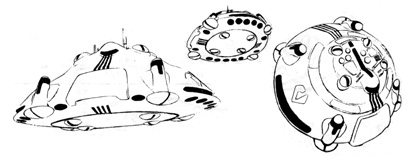

Designation:Frandlar Tiluvo class logistics dropship
|
|
||||

|
|||||
These vessels were built throughout the Robotech Mercantile Empire an entered service from 1630 through 2012. An exact number cannot be given due to the loss of records in the Invid invasion of Tirol and the destruction of the final remnants of the Tirolian fleet over Earth. However, an educated guess puts their numbers at 100,000,000+ individual units.
The REF refitted 70 of these vessels for micronian operation and used them as cargo dropships and temporary bases. During the hostilities, 6 were destroyed by enemy action, and the remainder were retired in 2039, when they had been replaced with the Horizont.
The Frandlar Tiluvo was the closest Zentraedi equivalent to the 'flying saucers' so often alleged to have visited the Earth. The dropship was far larger though than most 'UFO sightings', a quality forced by the sheer size of the Zentraedi and their mecha.
For a Zentraedi vehicle, the vessel had a unique propulsion system. Rather than the ubiquitous plasma-shock reaction engines, the dropship used fusion turbines, although turbines of a scale and power not seen before either on Tirol or elsewhere. The exhaust system was unique as well; the four turbines had their exhaust ejected at four dorsal or ventral vectorable exhaust pipes for vertical thrust and extremely fast attitude changes and evasions, and through a quadruple exhaust strip running bow and stern, for horizontal propulsion. This system was adopted to limit the damage the exhaust from a plasma-shock engine would do to its landing surfaces. The cooler exhaust coupled with the use of anti-gravity pods achieved this goal; the Frandlar Tiluvo had few landing restrictions.
The forward part of the vessel was dominated by a large drop-down hatch through which the interior cargo bay was accessible for even the largest mecha. The hatch itself would then serve as boarding ramp, and the cargo bay interior was only obstructed in the sides by three transverse frames. The propulsion and power generation installations were worked away in the sides of the vessel and behind the inner walls. The flight deck was located in the roof of the cargo bay, and seated three members of the crew. The flight deck access was in the Zentraedi version by a drop down ladder, controlled from a panel inside the vessel.
The Terran variants were salvaged Zentraedi Frandlar Tiluvo vessels, adapted for micronian crews. The flight deck was rebuilt, with the control area shrunken to human dimensions, and the remaining space used for a three level passenger compartment. Access was no longer by a drop down ladder but by an elevator and walkway on the walls and in the ceiling. The large cargo bay surface could easily be used to set up repair shops, headquarters buildings, hospitals and the like. Other adaptations were docking clamps to connect to the exterior of the larger Terran ships, and airlocks in the back and top so that mecha and personnel could be brought on board without depressurizing the entire cargo bay.
An additional note must be made of the use of Frandlar Tiluvo hulks as emergency housing after the Zentraedi Holocaust. The immense destruction on the Earth's surface and the large habitation requirements of the new Zentraedi populace caused a severe housing shortage. The rebuilding proceeded apace, but until the more normal housing was finished, many less-travelled areas, especially in tundra, desert and jungle regions, needed cheap housing. Many gutted Frandlar Tiluvo hulks were adapted for micronian or Zentraedi sized permanent habitation and used as such. Within 10 years though, housing was again sufficient and the immobile hulks were scrapped.
The Frandlar Tiluvo was designed as a general replacement for the various series of orbital transports then in use with the Zentraedi. As such, it served as both a general transport in the rear areas and as a combat transport, even though the Frandlar Tiluvo was not intended for the front line, and landed its troops away from enemy resistance (if necessary, under water) or in areas already secured by troops landed with cavalry power armours or by large ship fly-by.
This design was especially liked for its reliable operation, large cargo capacity and phenomenal maneuverability for an aircraft of its size. The eight vectorable exhausts enabled the Frandlar Tiluvo to execute aerobatics if required, although this was somewhat unwise if there was cargo on board during the maneuvers. In space especially, the nimbleness of the vessel made docking operations relatively easy, even when the available space was limited.
After the Zentraedi Holocaust the vessels were ubiquitous, and transported most of the aid shipments over the planet, as well as most of the evacuations. Several craft were fitted as hospitals and flown to disaster areas. Being a proven design, capacious, reliable, existing and cheap, the REF adopted the vessel as its main logistics and base vessel for the first decade and a half of its existence. They served as the main transports between ships and surface, and also as repair, hospital and HQ bases until ground facilities had been set up. They were too large to fit inside even the larger REF ships more than one at the time, and were carried with the other sub-light vessels between systems in the fold bubble of a larger ship, or attached to the outer hull of a larger ship such as a Tristar or Ajax class vessel.
Return to Zentraedi Naval Craft Index
Go to Robotech Reference Guide Home Page
Robotech (R) is the property of Harmony Gold. This document is in no way intended to infringe upon their rights.
Content by Pieter Thomassen with Peter Walker